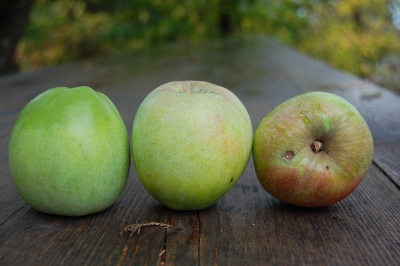︎︎︎ MELA
DEL CASTAGNO

Questa varietà è stata ritrovata nella zona di Mucignano, nel comune di Città di Castello (PG), in poderi di questa area. Da come raccontava il vecchio agricoltore che la coltivava ancora, è probabilmente un ecotipo spontaneo, nato dentro un tronco di castagno, riprodotto poi dai vari agricoltori intorno. Viene coltivata nelle zone da dove ha preso origine, in alta collina, vicino ai terreni coltivati a castagno. E’ una varietà molto pregiata per la rusticità della pianta e per le ottime caratteristiche organolettiche del frutto, che sono mantenute intatte per mesi. Adatta alla coltivazione di montagna ed alta collina. La pianta è vigorosa e molto rustica, a portamento espanso; produce in maniera costante, fiorisce in epoca medio tardiva. Il frutto è medio grande, di forma rotondeggiante, simmetrico, con il peduncolo grosso e lungo, inserito in una cavità media, acuta. Presenta una cavità calicina semiaperta. La buccia è lucida, liscia di colore verde con sfumature violacee e che a maturazione vira al giallo. Le lenticelle sono poco evidenti. La polpa è bianca, acidula, molto aromatica e croccante, di eccellente qualità.
Questa mela viene raccolta tradizionalmente con la luna calante di ottobre e si conserva egregiamente fino ad aprile. La maturazione avviene in fruttaio a partire da novembre. E’ molto serbevole.
It was recovered in the area of Mucignano, in a number of different properties in the municipality area of Citta’ di Castello (Perugia). According to an old farmer who was still cultivating it, it may be a seedling ecotype, born inside the hollow trunk of a chestnut tree and propagated by various farmers in the surrounding area. It is highly valuable for the toughness of the plant and the excellent organoleptic characteristics of the fruit. It is suitable for cultivation in the mountains and in the high hills. The plant is vigorous, very hardy, with a spreading habit. It crops regularly and blooms mid-late season. The fruit is medium-large, globose-conical and symmetrical, with a long, thick stem, inserted in an acute and moderate cavity. It has a semi-open calyx. The skin is shiny, smooth, green but veering to yellow with a purplish tinge at ripening time. The lenticels are not too marked. The flesh is white, slightly sour, very aromatic and crisp and of excellent quality. This apple is traditionally harvested with the waning moon in October and stores very well until April. The ripening takes place in the fruit-house starting from November. To keep this and other varieties it is advisable to build a fruit-house: a place that is not too cold and not too warm, not too ventilated and facing east or south. If it meets these requirements, it can be a cellar or an attic. For storing the fruit some shelves made of wood and covered with paper, straw or well dried moss are needed; pears should be placed standing up while apples should be standing on the side of the stem. In any case the fruit must be dried well before being stored.